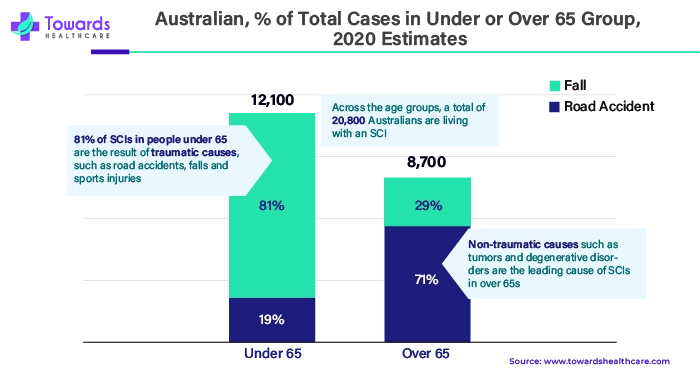
The Growing Impact of Spinal Cord Injuries on Older Adults
According to estimates from the National Spinal Cord Injury Association, approximately 282,000 individuals in the United States are affected by spinal cord injuries, with around 17,000 new cases diagnosed annually. As our world progresses, various factors like car accidents, falls, sports mishaps, and violent incidents contribute to the rising prevalence of spinal cord injuries, underscoring the need for spinal implants and devices.
With advancing age, individuals become more susceptible to spine-related issues such as degenerative disc disease and spinal cord injuries. As the global population ages, more people encounter these challenges.
Key Points on Spinal Injuries in Australia:
- Around 20,800 Australians have a spinal cord injury, typically caused by a traumatic event in their youth or middle age.
- Traumatic causes, including road accidents, falls, and sports injuries, account for 81% of spinal cord injuries in individuals under 65 years old.
- Non-traumatic causes, such as tumors and degenerative disorders, are the leading cause of spinal cord injuries in individuals over 65.
Download a short version of this report @ https://www.towardshealthcare.com/personalized-scope/5143
As people age, their spinal bones and discs can deteriorate, making them more prone to injury and conditions affecting the spinal cord. This can lead to difficulties with movement, sensation, and other bodily functions. Consequently, the demand for treatments addressing these spinal cord-related issues increases with a growing older population.
Treating spinal cord injuries often involves a combination of interventions, including surgery to repair the spine and rehabilitation to relearn movement and regain function. With the increasing number of older adults experiencing these problems, there is a heightened need for such treatments.
Healthcare providers and researchers are diligently working to develop new and improved methods for treating spinal cord injuries and age-related spine conditions. Their aim is to enhance the quality of life for those affected by these challenges through advancements in medical technology and rehabilitation techniques.
Advanced Techniques Revolutionizing Spinal Cord Injury Treatment
In the ongoing battle against spinal cord injuries, scientists and doctors are harnessing cutting-edge technologies to offer new hope and possibilities to those affected. Advanced surgical techniques are enabling precise repairs of damaged spines, while neuroprosthetics are granting individuals the ability to control their limbs through technology, akin to a superpower. Additionally, regenerative medicine is showing promise in repairing damaged spinal cords, aiming to restore lost functions and improve quality of life.
Recent strides in spinal cord injury (SCI) research, supported by the National Institute of Neurological Disorders and Stroke (NINDS), are focused on:
- Electrical Stimulation Systems: Researchers are developing systems that utilize electrical stimulation to restore hand function, postural control, and bowel and bladder control for individuals with spinal cord injuries, with funding from NINDS.
- Spinal Cord Stimulation: Another area of focus is stimulating the spinal cord below the injury level to support preserved cells and fibers in functioning properly, also supported by NINDS.
- Brain-Computer Interfaces (BCIs): Experimental BCIs are being pioneered to allow direct control of a computer cursor or robotic arm with brain signals, led by NINDS.
However, progress extends beyond mere physical repairs; it also involves teaching the body to adapt and thrive again. Rehabilitation methods play a crucial role in helping individuals with spinal cord injuries regain movement and functionality through specialized exercises and therapies.
Recent breakthroughs and trials include:
- KA-301: In August 2023, Kaneka Corporation began testing this treatment derived from stem cells obtained from human amnion (part of the placenta) on individuals with acute spinal cord injuries.
- NVG-291: In September 2023, NervGen Pharma Corporation administered the first dose of their experimental drug to a participant in a trial for spinal cord injuries, aiming to assess its efficacy.
- Spinal Implant Innovations: In October 2022, Rosies Base and SpineCraft joined forces to develop enhanced spinal implants utilizing nanoTi, a special type of titanium, for treating back injuries and related issues.
These advancements offer renewed hope to those with spinal cord injuries, not only by improving current treatments but also by introducing new avenues for intervention. As long as scientists continue to push the boundaries of science, countless lives stand to benefit from these remarkable advancements.
Challenges and Innovations in Treating Complete Spinal Cord Injuries
Complete spinal cord injuries pose significant challenges and necessitate lifelong care due to their permanent nature, often resulting from severe trauma like car accidents or falls. These injuries lead to lifelong disabilities, requiring ongoing medical attention, rehabilitation, and assistive devices.
Traumatic spinal cord injuries in Australia occur from various causes, with the growing patient population driving demand for advanced treatment options such as surgical interventions, neuroprosthetics, and regenerative medicine. Surgeons employ advanced techniques to repair the spine, while neuroprosthetics offer hope by restoring lost functions through devices like exoskeletons or nerve stimulators. Regenerative medicine explores methods to repair damaged spinal cords, potentially enabling recovery for those with complete injuries. Additionally, rehabilitation plays a crucial role in helping individuals adapt and improve their quality of life and independence.
However, despite advancements in medical technology, treating complete spinal cord injuries still presents challenges. Current treatments primarily focus on managing symptoms and preventing further damage rather than fully restoring function. While doctors can provide care to reduce pain, manage complications, and prevent secondary issues like infections or pressure sores, they can’t completely reverse spinal cord damage.
The complexity of the spinal cord contributes to these limitations, as it serves as a nerve superhighway transmitting messages from the brain to the body. When injured, this connection is disrupted, hindering signal transmission. Moreover, spinal cord cells don’t repair themselves as readily as cells in other parts of the body.
Researchers continuously seek new treatments to repair the spinal cord and restore function, but it remains a complex challenge. Until then, the focus remains on providing the best care possible to manage symptoms, prevent complications, and enhance quality of life.
Geographically, North America, particularly the United States and Canada, stands as a major hub for treating spinal cord injuries, boasting ample resources and facilities for research and treatment. The prevalence of spinal injuries in the U.S. drives growth in the spinal cord injury treatment market.
In the Asia Pacific region, including countries like China, Japan, India, and Australia, the landscape for spinal cord injury treatment varies. Factors such as healthcare infrastructure quality, regulations, and cultural attitudes toward disabilities influence treatment availability and acceptance.
In the competitive landscape, pharmaceutical companies develop drugs to alleviate symptoms and promote recovery after spinal cord injuries. Innovative rehabilitation devices, robotics, and assistive technologies aim to enhance mobility and function. Additionally, providers of imaging technologies and diagnostic tools aid in accurate assessment and monitoring of spinal cord injuries.
To own our research study instantly, Click here @ https://www.towardshealthcare.com/price/5143
Read more about Spinal Cord Injury Treatment Market:
You can place an order or ask any questions, please feel free to contact us at sales@towardshealthcare.com
About Us
Healthcare Web Wire is a premier subsidiary of Towards Healthcare, dedicated to providing comprehensive insights and information related to the healthcare industry. With a commitment to delivering accurate and timely updates, Healthcare Web Wire serves as a vital resource for professionals, enthusiasts, and stakeholders within the healthcare sector. Our platform serves as a central hub for the latest news, trends and developments shaping the healthcare landscape. Join us on Healthcare Web Wire and become part of a vibrant community dedicated to advancing healthcare knowledge and shaping the future of healthcare worldwide.
Explore the comprehensive statistics and insights on healthcare industry data and its associated segmentation: Get a Subscription
For Latest Update Follow Us: https://www.linkedin.com/company/towards-healthcare



